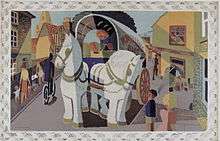Tom Gentleman
Thomas Gentleman FSIA[1] (13 May 1892 – 29 November 1966) was a Scottish painter[2] and commercial artist. He was the father of noted artist David Gentleman.[3]

Early life
Gentleman was born in Coatbridge, Lanarkshire, in 1892. His parents were Anne Cowan (née McNaughtan) and William Russell Gentleman, who had a drapery business in the town. In April 1901, when Tom was nine, his father died following surgery. At the age of 13, although already apprenticed as a draper and expected to go into the family business, he began evening classes at the Glasgow School of Art, becoming in 1911 a full-time student until in 1914 he was mobilised.
Career and First World War
Gentleman received his diploma from the Glasgow School of Art in 1914, after becoming a full-time student in 1911. He was awarded the Haldane Travelling Scholarship, but the outbreak of war in Europe meant that the trip had to be postponed until 1920–21. During the trip he visited Corsica, Italy, France and Spain. Other recipients of the Haldane Travelling Scholarship include Alexander Proudfoot (1908), and Loris Ray (1926).
In 1912, Gentleman had begun to volunteer with the Queen's Own Royal Glasgow Yeomanry. Consequently, he was mobilised for service in August 1914, until his eventual demobilisation in 1918, after which he returned to Glasgow School of Art, and continued to take classes in painting and drawing. He served with both the Scottish Rifles and the Glasgow Yeomanry.[4]
Painter and designer
Gentleman worked as a painter, printmaker, cartoonist and freelance graphic designer from 1921, periodically exhibiting his paintings. He was for a short time a teacher at the first technical college in Britain, the Coatbridge Technical School. In 1928 he moved to London, began to work in advertising, and married a fellow ex-student of Glasgow School of Art, Eugenie Winifred Murgatroyd, a painter who later became a weaver. After they moved to Hertford in 1930 they had two sons, David (born in 1930) and Hugh (born in 1935).
Gentleman worked in several advertising agencies and from 1932 in the design studio at Shell Mex. During the 1939–45 war he worked for several years for the Ministry of Information and then as a freelance, during which time he wrote and illustrated a children's book called Brae Farm, a memoir of his Scottish childhood, which was published in 1945. His best known works are his lithograph The Grey Horses, published by School Prints in 1946, and two earlier posters for Shell. After the war he returned to Shell Mex as its Studio Manager. He was elected Fellow of the Society of Industrial Artists in 1947. In 1952 he retired, and in 1956 moved with Winifred to Essex, where he went on drawing and painting for the rest of his life. Tom and Winifred Gentleman died in 1966 in Colchester, Essex.[2]
Gentleman is listed on the Glasgow School of Art's First World War Roll of Honour.[5]
Further reading
- National Archives The Art of War: Tom Gentleman
- Eye Magazine article on David Gentleman
References
- Gentleman, Tom. "FSIA". ArtBiogs. Retrieved 31 July 2016.
- 4 paintings by or after Tom Gentleman, Art UK. Retrieved 18 September 2015.
- "Gentleman, David (William)". Who's Who 2017. Oxford University Press. 2017. Retrieved 24 July 2017.
- "Tom Gentleman (1882–1966)". British Council, Visual Arts. Archived from the original on 5 March 2015. Retrieved 19 September 2015.
- Gentleman, Tom. "Roll of Honour". Glasgow School of Art: Archives and Collections. Retrieved 18 September 2015.